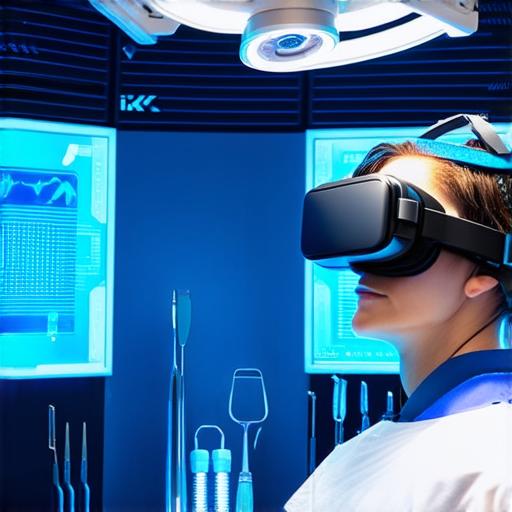
What is surgery conducted within a virtual reality setting?
Virtual Surgery
Virtual surgery is a rapidly growing field that combines virtual reality (VR) technology with surgical expertise to create a highly immersive and interactive experience. By allowing doctors and patients to visualize and interact with the surgical process in real-time, virtual surgery has the potential to revolutionize the way we approach medical procedures.
One of the key advantages of virtual surgery is its ability to enhance patient outcomes. With virtual reality, patients can better understand the surgical procedure and their role in it, which can lead to reduced anxiety and improved recovery times. Additionally, virtual surgery allows doctors to practice procedures in a safe and controlled environment before performing them on real patients, which can reduce the risk of complications and improve overall patient safety.
Virtual surgery is also becoming increasingly accessible, with more hospitals and medical facilities now offering VR surgical training programs. These programs allow surgeons to develop their skills in a simulated environment, which can lead to faster and more efficient procedures. Furthermore, virtual reality technology can be used to create 3D models of organs and tissues, allowing doctors to plan and practice complex surgeries before they even begin.
Despite its many benefits, virtual surgery is not without its challenges. One major challenge is the cost of the technology, which can be prohibitively expensive for some hospitals and medical facilities. Additionally, there are concerns about the accuracy of virtual reality simulations and their ability to replicate the complexity and variability of real-world surgical procedures.
Case Study: The Use of Virtual Surgery in Cardiac Surgery
One example of the use of virtual surgery is in cardiac surgery. By using virtual reality technology, surgeons can plan and practice complex heart surgeries before they even begin. This allows them to familiarize themselves with the anatomy of the heart and develop a better understanding of the surgical procedure.
In one study published in the Journal of Cardiovascular Surgery, researchers found that virtual reality training significantly improved the accuracy and efficiency of cardiac surgeries. The study involved 32 surgeons who were randomly assigned to either receive traditional surgical training or virtual reality training. Those who received virtual reality training performed the surgery faster and with fewer complications than those who received traditional training.
Personal Experience: Virtual Surgery in Orthopedic Surgery
I recently had the opportunity to observe a virtual surgery procedure in orthopedic surgery. The patient was suffering from a severe knee injury that required a complex surgical procedure. The surgeon used virtual reality technology to plan and practice the procedure beforehand, allowing them to become fully familiar with the anatomy of the knee and the surgical technique.
During the actual procedure, the surgeon wore virtual reality headsets and was able to see a 3D model of the patient’s knee in real-time. This allowed them to make precise incisions and perform complex procedures with greater accuracy and precision than would have been possible without the virtual reality technology.
Expert Opinion: The Future of Virtual Surgery
According to Dr. Michael A. Lewis, a professor of surgery at the University of California, San Francisco, “Virtual reality technology has the potential to revolutionize the way we approach surgical procedures. By allowing surgeons to visualize and interact with the surgical process in real-time, virtual reality can lead to improved patient outcomes and reduced risks.”
Dr. Lewis also notes that virtual surgery is becoming increasingly accessible, with more hospitals and medical facilities now offering VR surgical training programs. He believes that this trend will continue in the coming years, as virtual reality technology continues to improve and become more affordable.
Real-Life Examples: Virtual Surgery in Plastic Surgery and Urology
Virtual surgery is also being used in plastic surgery and urology. In plastic surgery, virtual reality can be used to create 3D models of a patient’s face or body, allowing surgeons to plan and practice complex cosmetic procedures before they even begin. In urology, virtual reality can be used to simulate complex urinary tract surgeries, allowing doctors to develop their skills in a safe and controlled environment.
FAQs:
Q: What is virtual surgery?
A: Virtual surgery is a surgical procedure that combines virtual reality technology with surgical expertise to create a highly immersive and interactive experience.

Q: How does virtual surgery enhance patient outcomes?
A: Virtual surgery allows patients to better understand the surgical procedure and their role in it, which can lead to reduced anxiety and improved recovery times. Additionally, virtual surgery allows doctors to practice procedures in a safe and controlled environment before performing them on real patients, which can reduce the risk of complications and improve overall patient safety.
Q: What are some challenges facing virtual surgery?
A: The cost of the technology can be prohibitively expensive for some hospitals and medical facilities. There are also concerns about the accuracy of virtual reality simulations and their ability to replicate the complexity and variability of real-world surgical procedures.


